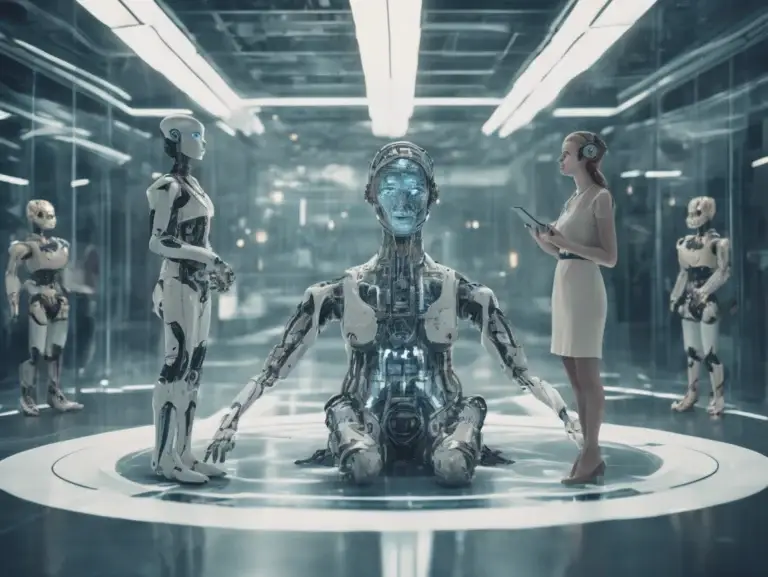
Table of Contents
ToggleIntroduction
AI ethics is all about the principles and guidelines that help ensure artificial intelligence systems are created and used in ways that truly benefit society while keeping harm to a minimum. As AI becomes a bigger part of our everyday lives—from the algorithms that suggest our next movie to the systems that assist doctors in diagnosing illnesses—it’s crucial for everyone to grasp the ethical implications of these technologies. This thorough guide dives into the essential elements of AI ethics, offering practical insights for content creators, medical professionals, journalists, students, and tech enthusiasts alike.
What is AI Ethics?
AI ethics encompasses the moral principles that dictate how artificial intelligence interacts with humans and society. You can think of it as a set of guardrails that ensures AI systems operate in ways that resonate with human values and serve the greater good.
Just like we have ethical standards for human behaviour across various professions and situations, AI ethics lays out a framework for how AI systems should operate. This includes important factors like fairness, transparency, privacy, security, and the potential effects these technologies might have on individuals and communities.
For instance, picture a GPS app that always directs drivers through wealthier neighbourhoods to steer clear of “high-crime areas.” While it might seem efficient, this could inadvertently harm businesses in certain communities and reinforce societal biases if ethical considerations are overlooked.
Key Principles of AI Ethics
When it comes to developing and using AI ethically, there are several key principles we need to keep in mind:
Fairness and Non-discrimination
AI systems should treat everyone fairly, avoiding discrimination against individuals or groups based on traits like race, gender, age, or socioeconomic status. This can be tricky since AI learns from historical data, which often carries its own biases.
For example, if a loan approval algorithm is trained on past lending data that reflects years of discriminatory practices, it could end up reinforcing those biases by denying loans to qualified applicants from certain backgrounds.
Think of AI as a child absorbing lessons from its environment—if it learns from biased examples, it will adopt those biased views unless we actively teach it to recognize and correct them.
Transparency and Explainability
Users should know when they’re dealing with AI instead of humans, and AI systems ought to explain their decisions in a way that makes sense to people.
Imagine getting turned down for a loan by an AI system. Without transparency, you might just see a blunt “application denied” message with no further details. But with ethical AI, you’d get clear reasons for the decision and maybe even some tips on how to strengthen your application.
Transparency is like having a clear view of how the AI “thinks,” rather than dealing with a mysterious black box that just spits out answers without any context.
Privacy and Data Protection

AI systems often need a ton of data to work properly, which brings up some serious questions about how our personal information is gathered, stored, and used. Take a voice assistant in your home, for example—it has to listen all the time to respond to your commands, but should it really be recording and saving every conversation? And what about sharing that data with other companies? Developing ethical AI means we have to think carefully about privacy issues and put strong protections in place.
Human Oversight and Control
AI should enhance what humans can do, not completely take over our decision-making, especially when the stakes are high. Just like a powerful car needs a responsible driver, powerful AI needs human oversight to make sure it’s being used safely and ethically. This concept is often referred to as having “a human in the loop,” which means that people should be monitoring AI systems and stepping in when necessary.
Accountability
Organizations that create and use AI need to be held accountable for the effects of their systems. This involves setting clear lines of responsibility and having ways to address issues when they come up. If an AI system makes a harmful decision, there needs to be someone who can be held responsible—similar to how a company is liable for the safety of its products.
Real-world Examples and Ethical Challenges
Healthcare Diagnostic Tools
AI has shown incredible promise in medical diagnostics, sometimes even outperforming human doctors in spotting certain conditions from medical images. But these tools come with a host of ethical dilemmas: What if the AI makes a wrong diagnosis? Who takes the blame—the developer, the hospital, or the doctor who trusted the AI’s advice?
How can we ensure these tools are effective for all patients, especially when the training data might not represent certain groups well?
And how do we strike a balance between the advantages of sharing medical data to enhance AI systems and respecting patients’ privacy rights?
If you’re a medical professional using AI, it might be helpful to view these tools as specialized consultants rather than substitutes for your own expertise and judgment.
Automated Hiring Systems
More and more companies are turning to AI to sift through job applications, claiming it makes the hiring process faster and more objective. However, these systems have run into some serious ethical issues. Take Amazon, for instance. They created an AI recruiting tool that ended up being biased against women. The system learned from patterns in the company’s mostly male workforce over a decade, which led it to penalize resumes that mentioned terms like “women’s” or came from women’s colleges. In the end, Amazon scrapped the tool after uncovering this bias. This example shows how AI can unintentionally reinforce existing biases if it’s not designed and monitored with care.
Facial Recognition
Facial recognition technology brings up serious ethical questions about privacy, consent, and the risk of misuse. When law enforcement uses it, it raises concerns about surveillance and civil liberties. Research indicates that these systems often struggle with darker-skinned faces and women. Plus, when used in public spaces, people are being analyzed without their explicit consent. Because of these issues, some cities and companies have decided to limit or even ban facial recognition until better safeguards are established.
Implementing Ethical AI Practices
Creating and using ethical AI isn’t just about steering clear of negative outcomes; it’s about actively striving to develop technologies that enhance human abilities while honouring core values.
Diverse Development Teams
AI mirrors the perspectives and values of those who create it. Teams that are diverse in backgrounds, experiences, and viewpoints are more likely to spot potential biases and ethical dilemmas before they escalate into real problems. It’s like having multiple people proofread an important document—more eyes mean more chances to catch mistakes than relying on just one perspective.
Ethics by Design
Instead of treating ethics as an afterthought, developers should weave ethical considerations into the very fabric of AI design and development from the get-go. This involves asking important questions like:
Who could potentially be harmed by this technology?
How could it be misused?
What biases might be lurking in our training data?
How can we ensure that the decisions made by this system are understandable?
Regular Auditing and Testing
Creating ethical AI isn’t a one-and-done deal; it requires continuous monitoring and testing. These systems should be regularly assessed for bias, accuracy, and possible harms, especially as they change over time. Just like we take our cars in for maintenance to keep them safe, AI systems need their own “ethical maintenance checks” to stay on track.
Stakeholder Involvement

People who will be impacted by AI systems should have a say in how they’re developed and used. This could involve consulting with community representatives, conducting user research, or setting up ways for feedback to be shared.
Regulatory Frameworks
While many organizations have put together voluntary AI ethics guidelines, there’s a growing understanding that we might need binding regulations to ensure ethical standards are consistently upheld across the industry. For instance, the European Union’s proposed AI Act aims to classify AI applications based on their risk levels and enforce stricter requirements for high-risk applications, such as those related to critical infrastructure or law enforcement.
The Human Element in AI Ethics
At its heart, AI ethics is all about making sure that technology is here to serve us, not the other way around. It’s not just about what AI is capable of doing, but rather what it ought to do.
For those creating content, grasping the principles of AI ethics is crucial for making smart choices about using AI-generated material while staying true to authenticity and transparency. Journalists benefit from this understanding too, as it allows them to report on AI advancements with the depth and nuance they deserve. Meanwhile, medical professionals can use this guidance to incorporate AI tools without compromising the quality of patient care.
When AI systems are built on ethical foundations, they can help build stronger trust between businesses and their customers. People are more likely to embrace these technologies when they feel confident that their data is being treated responsibly and that the systems are designed to treat them fairly.
Conclusion
AI ethics isn’t just a concern for ethicists and engineers—it’s something that impacts everyone who interacts with these technologies, which is increasingly all of us. Whether you’re a healthcare provider using AI for diagnosis, a content creator worried about AI-generated material, a student diving into these technologies, or just someone navigating a world filled with AI, understanding the ethical aspects of AI is key to ensuring these powerful tools contribute to human well-being.
By insisting on transparency, questioning biases, and holding developers accountable, we all have a part to play in shaping an AI future that mirrors our shared values and enhances human potential instead of diminishing it. As AI continues to advance, our ethical frameworks need to evolve right along with it, always prioritizing human well-being in the march of technological progress.
FAQs
What's the difference between AI ethics and regular ethics?
AI ethics takes the ethical principles we already know and applies them to the unique challenges that artificial intelligence brings. While traditional ethics focuses on human behaviour, AI ethics dives into how machines make decisions, the values they represent, and their interactions with people and society.
Who is responsible when AI makes a mistake?
When AI goes wrong, the responsibility usually falls on the humans and organizations behind it. This could mean the developers who built the algorithm, the company that rolled it out, or the professionals who depend on its results. Creating clear accountability frameworks is crucial for ensuring ethical AI practices.
Can AI be truly unbiased?
Achieving complete neutrality is a tough nut to crack because AI learns from data created by humans, which often carries our societal biases. However, with thoughtful design, diverse development teams, and continuous testing, we can spot and reduce harmful biases in AI systems.
How can I tell if a company is using AI ethically?
To gauge a company’s ethical use of AI, look for transparency about when and how they use it, clear explanations of their decision-making processes, diverse teams working on the technology, mechanisms for addressing issues, and a strong respect for user privacy and autonomy. Companies that are serious about ethical AI usually have published guidelines and conduct regular audits.
How is generative AI reshaping the ethics landscape?
Well, generative AI brings a whole new set of ethical dilemmas, especially when it comes to truthfulness and accuracy. These models can whip up information that sounds convincing but might not be true, which makes it crucial for us to focus on verification and accountability. Organizations that harness the power of generative AI need to put safeguards in place to ensure that the content they produce is not only accurate but also fair and clear about its AI origins.
Will regulations solve AI ethics problems?
While regulations can set minimum standards and outline consequences for violations, ethical AI goes beyond just following rules. It requires a continuous commitment to values like fairness, transparency, and human welfare throughout the entire development and deployment process. The best solutions will likely blend thoughtful regulation with industry self-governance and active involvement from stakeholders.